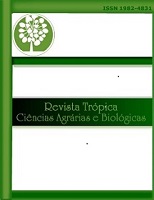DISTRIBUTION, AREAS OF ENDEMISM AND CONSERVATION OF ENDEMIC SPECIES OF THE CLADE HIPPOMANOIDE IN BAHIA, BRAZIL
Keywords:
spatial analysis, botany, Euphorbiaceae, Hippomaneae, northeast, taxonomyAbstract
Hippomanoide is one of the clades that emerged in the Euphorbioideae and comprises the Hureae, Pachystromateae and Hippomaneae tribes. Many species of the clade are recorded in eastern Brazil and seven of them are endemic to Bahia. The present work aimed to determine the geographic distribution, richness patterns, areas of endemism and conservation status of the endemic species of Hippomanoide in Bahia. For the analysis and preparation of the maps, the geographic coordinates obtained from the specimens in the virtual herbaria and specialized literature were used. Microstachys uleana is the species with the greatest range of distribution while Stillingia loranthacea, Microstachys revoluta, Ophthalmoblapton parviflorum and Sebastiania trinervia were the most restricted. The central region of Bahia emerged as the holder of the greatest species richness of the clade, and the one with the highest endemicity. However, this region is also the target of constant anthropogenic pressure. We conclude that, although two of the three endangered species have some protected populations in Conservation Units, we draw attention to the need for protective measures in the environments where the species of the Clade occur, especially because some of them are very restricted and even known only by type collection.
Downloads
References
BRASIL. Ministério do Meio Ambiente. Gabinete do Ministro. Portaria nº 148, de 7 de junho de 2022.
BRASIL. Biodiversidade in: Ministério do Meio Ambiente. Disponível em: <https://www.gov.br/mma/pt-br/assuntos/biodiversidade#:~:text=O%20Brasil%20ocupa% 20quase %20metade,e%20tr%C3%AAs%20grandes%20ecossistemas%20marinhos.>. Acesso em: 27 de junho de 2023.
FLORA E FUNGA DO BRASIL. Jardim Botânico do Rio de Janeiro. Disponível em: <http://floradobrasil.jbrj.gov.br/>. Acesso em: 05 jul. 2022.
HIJMANS, R.J.; CAMERON, S.E.; PARRA, J.L.; JONES, P.G.; JARVIS, A. Very high-resolution interpolated climate surfaces for global land areas. International Journal of Climatology, v. 25, p. 1965–1978. 2005.
IBGE. art. 1º: Fica alterada, na forma do ANEXO, a caracterização do Sistema Geodésico Brasileiro. Resolução no 1/2005. Brasil, 2005.
IBGE. Malhas digitais. Instituto Brasileiro de Geografia e Estatística, Brasil, 2020. Disponível em: https://mapas.ibge.gov.br/bases-e-referenciais/bases-cartograficas/malhas-digitais. Acesso em: 23 dez. 2022.
STAFLEU, F.A.; COWAN, R.S. Taxonomic literature. Regnum vegetabile, Utrecht, v. 94, p. 1-1136. 1976.
WURDACK, K.J.; HOFFMANN, P. & CHASE, M. W. Molecular phylogenetic analysis of uniovulate Euphorbiaceae (Euphorbiaceae sensu stricto) using plastid rbcL and trnL-F DNA sequences. American Journal of Botany, 92(8), p. 1397–1420. 2005.
Downloads
Published
How to Cite
Issue
Section
License

This work is licensed under a Creative Commons Attribution-NonCommercial-NoDerivatives 4.0 International License.
Direitos autorais Revista Trópica: Ciências Agrárias e Biológicas
Este obra está licenciado com uma Licença Creative Commons Atribuição-NãoComercial-SemDerivações 4.0 Internacional.








